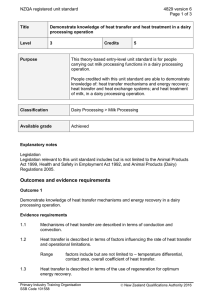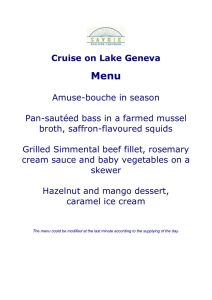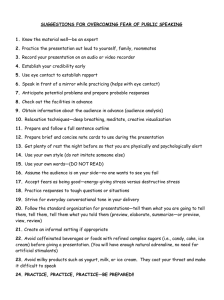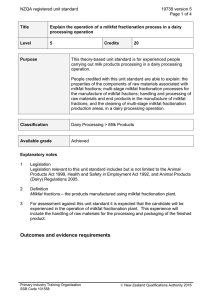NZQA registered unit standard 4830 version 6 Page 1 of 4
advertisement
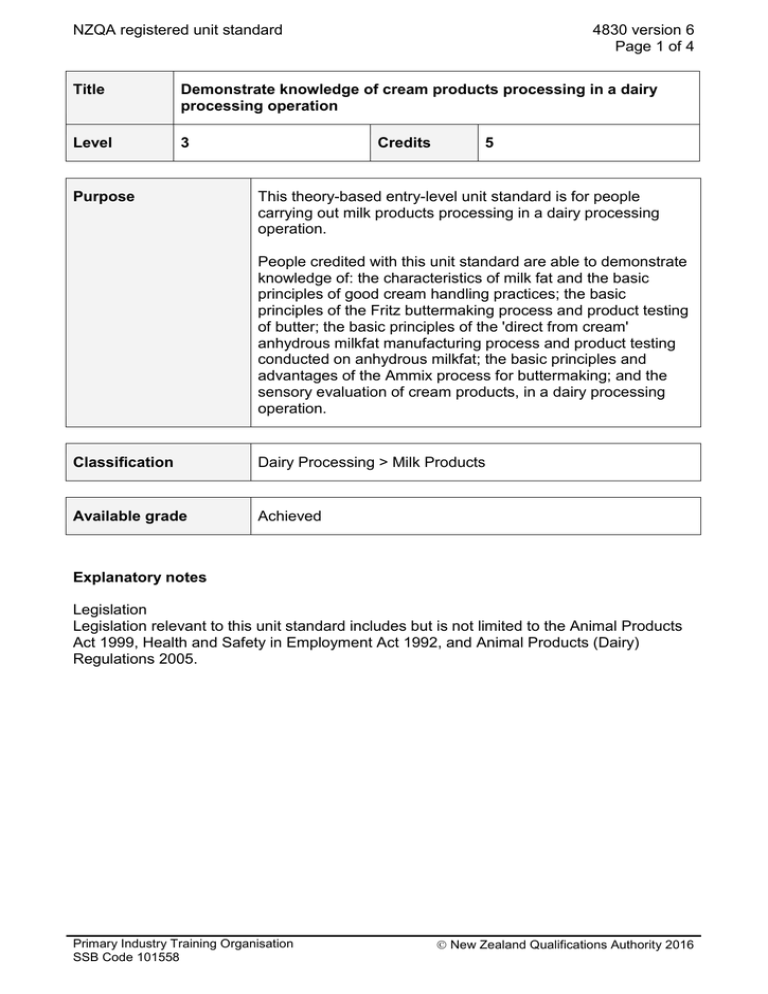
NZQA registered unit standard 4830 version 6 Page 1 of 4 Title Demonstrate knowledge of cream products processing in a dairy processing operation Level 3 Purpose Credits 5 This theory-based entry-level unit standard is for people carrying out milk products processing in a dairy processing operation. People credited with this unit standard are able to demonstrate knowledge of: the characteristics of milk fat and the basic principles of good cream handling practices; the basic principles of the Fritz buttermaking process and product testing of butter; the basic principles of the 'direct from cream' anhydrous milkfat manufacturing process and product testing conducted on anhydrous milkfat; the basic principles and advantages of the Ammix process for buttermaking; and the sensory evaluation of cream products, in a dairy processing operation. Classification Dairy Processing > Milk Products Available grade Achieved Explanatory notes Legislation Legislation relevant to this unit standard includes but is not limited to the Animal Products Act 1999, Health and Safety in Employment Act 1992, and Animal Products (Dairy) Regulations 2005. Primary Industry Training Organisation SSB Code 101558 New Zealand Qualifications Authority 2016 NZQA registered unit standard 4830 version 6 Page 2 of 4 Outcomes and evidence requirements Outcome 1 Demonstrate knowledge of the characteristics of milk fat and the basic principles of good cream handling practices in a dairy processing operation. Evidence requirements 1.1 Characteristics of milk fat are described in terms of the structure and properties of the major components. Range 1.2 characteristics include but are not limited to – triglycerides, saturated and unsaturated fatty acids, melting points, phospholipids. Basic principles of good cream handling practices are described in terms of the prevention of damage to cream components. Range damage includes but is not limited to – flavour, lipolysis, gelling, fat losses during cream processing. Outcome 2 Demonstrate knowledge of the basic principles of the Fritz buttermaking process and product testing of butter in a dairy processing operation. Evidence requirements 2.1 The basic principles of whole milk separation and cream treatment are described in terms of their role and importance in ensuring high quality cream for buttermaking. Range 2.2 The major stages of the Fritz buttermaking process are described in terms of their role and importance in achieving high quality butter. Range 2.3 principles include but are not limited to – whole milk holding, whole milk separation, cream treatment, crystallisation. stages include but are not limited to – churning, buttermilk separation, working, butter pumping. Product tests conducted on butter are described in terms of their purpose and typical specification limits. Range product tests include but are not limited to – moisture, salt, curd, sediment, fat, microbiological. Primary Industry Training Organisation SSB Code 101558 New Zealand Qualifications Authority 2016 NZQA registered unit standard 4830 version 6 Page 3 of 4 Outcome 3 Demonstrate knowledge of the basic principles of the ‘direct from cream’ anhydrous milkfat manufacturing process and product testing conducted on anhydrous milkfat in a dairy processing operation. Evidence requirements 3.1 The major stages of the anhydrous milkfat manufacturing process are described in terms of their role and importance in achieving high quality anhydrous milkfat. Range 3.2 stages include but are not limited to – concentration, phase inversion, oil separation, neutralisation, vacreation, dehydration, pumping, storage, packing. Product tests conducted on anhydrous milkfat are described in terms of their purpose and typical specification limits. Range product tests include but are not limited to – moisture, fat, free fatty acid, peroxide value, alkalinity, dissolved oxygen, headspace oxygen, flavour, clarity. Outcome 4 Demonstrate knowledge of the basic principles and advantages of the Ammix process for buttermaking in a dairy processing operation. Evidence requirements 4.1 The Ammix process for buttermaking is explained in comparison with the Fritz buttermaking process. Range 4.2 stages include but are not limited to – blending, scraped-surface cooling, working, holding, packing. The Ammix process for buttermaking is described in terms of its advantages over the Fritz buttermaking process. Outcome 5 Demonstrate knowledge of the sensory evaluation of cream products. Evidence requirements 5.1 Sensory evaluation of cream products is described in terms of the senses involved in sensory evaluation and the sensory characteristics of butter and anhydrous milkfat. Range characteristics include but are not limited to – flavour, body, texture, colour. Primary Industry Training Organisation SSB Code 101558 New Zealand Qualifications Authority 2016 NZQA registered unit standard Planned review date 4830 version 6 Page 4 of 4 31 December 2020 Status information and last date for assessment for superseded versions Process Version Date Last Date for Assessment Registration 1 22 June 1995 31 December 2014 Review 2 5 July 1999 31 December 2014 Review 3 26 August 2002 31 December 2014 Revision 4 13 June 2003 31 December 2014 Rollover 5 17 July 2009 31 December 2016 Review 6 18 June 2015 N/A Consent and Moderation Requirements (CMR) reference 0022 This CMR can be accessed at http://www.nzqa.govt.nz/framework/search/index.do. Please note Providers must be granted consent to assess against standards (accredited) by NZQA, before they can report credits from assessment against unit standards or deliver courses of study leading to that assessment. Industry Training Organisations must be granted consent to assess against standards by NZQA before they can register credits from assessment against unit standards. Providers and Industry Training Organisations, which have been granted consent and which are assessing against unit standards must engage with the moderation system that applies to those standards. Requirements for consent to assess and an outline of the moderation system that applies to this standard are outlined in the Consent and Moderation Requirements (CMRs). The CMR also includes useful information about special requirements for organisations wishing to develop education and training programmes, such as minimum qualifications for tutors and assessors, and special resource requirements. Comments on this unit standard Please contact the Primary Industry Training Organisation standards@primaryito.ac.nz if you wish to suggest changes to the content of this unit standard. Primary Industry Training Organisation SSB Code 101558 New Zealand Qualifications Authority 2016
